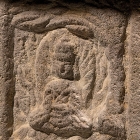J.J. Lally & Co., Oriental Art / New York City, New York
MenuPast Exhibition
Buddhist Sculpture from Ancient China
March 10-31, 2017
3.
AN INSCRIBED RED SANDSTONE BUDDHIST STELE
Northern Wei Dynasty, dated by inscription 500
the principal side of the short quadrangular pillar carved in relief with a figure of the Buddha with right hand held open in abhaya mudra seated in a niche backed by flame motifs, between two more shallow niches on the adjacent sides, one carved in relief with the Buddha standing between two bodhisattvas below a pair of apsaras with arms outstretched holding a large lotus flower, the other niche carved in relief with the Buddha seated in meditation beneath the arching branches of a tree and with two bodhisattvas in conversation below, the reverse side of the pillar with a flat gridded panel filled with a dedicatory inscription, all surmounted by a four-sided peaked roof with ribs and ridges simulating tilework and raised on a stepped platform base incised with lines to indicate brickwork.
Height 10 1⁄4 inches (26 cm)
The carved inscription begins with a date which may be read as 景明元年七月十日 and may be translated as “tenth day, seventh month, first year [of the reign of] Jing Ming,” corresponding to A.D. 500.
Compare the Northern Wei stone Buddhist stele of closely related form in the collection of the Taito City Calligraphy Museum, Tokyo, dated by inscription to the 2nd year of Yanxing (A.D. 472), illustrated in Hokugi seikizō bukkyō chōkkoku no tenkai (Development of Buddhist Sculpture in Northern Wei Dynasty China), Osaka, 2013, pp. 16-17, no. 02.
Compare also the Northern Wei stone carving of a seated Buddha with very similar treatment of the drapery of the robes, illustrated by Matsubara, Chūgoku bukkyō chōkokushi kenkyū (Chinese Buddhist Sculpture: A Study Based on Bronze and Stone Statues other than Works from Cave-Temples), Tokyo, 1966, pl. 54a, with description on p. 238.
北魏 景明元年款 砂岩佛龕 高 26 厘米
